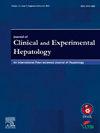治疗中肝硬化或肝细胞癌的风险无差异Naïve慢性乙型肝炎患者的基线乙型肝炎病毒载量:倾向评分加权分析
IF 3.3
Q2 GASTROENTEROLOGY & HEPATOLOGY
Journal of Clinical and Experimental Hepatology
Pub Date : 2025-03-03
DOI:10.1016/j.jceh.2025.102540
引用次数: 0
摘要
背景和目的先前对韩国成人treatment-naïve慢性乙型肝炎(CHB)患者的研究发现,乙型肝炎病毒(HBV) DNA基线与肝细胞癌(HCC)风险之间存在矛盾关系。然而,这些观察结果尚未在西方队列中得到验证。我们的目的是评估treatment-naïve非肝硬化慢性HBV患者发生肝硬化或HCC的纵向风险。方法采用2020年1月1日至2024年3月31日期间美国CHB退伍军人(基线HBV DNA≥2000 IU/mL)的国家队列,我们评估了基线高HBV DNA (>6.00 log10 IU/mL)或中度HBV DNA (2000 - 6.00 log10 IU/mL)分层的肝硬化或HCC的长期风险。我们应用倾向得分加权法来调整两组之间的基线差异。结果共检出HBV DNA≥2000 IU/mL的非肝硬化treatment-naïve CHB患者1198例(90.7%为男性,41.7%为非洲裔美国人,29.6%为非西班牙裔白人,18.2%为亚裔,平均年龄54.7岁,27.9%为HBeAg阳性)。应用倾向评分加权后,肝硬化或HCC的发生率在中度和高基线HBV DNA的CHB患者之间没有显著差异(肝硬化:1.02 (95% CI: 0.83-1.25) vs 1.19 / 100人-年(95% CI: 0.94-1.51);Hr 0.93, 95% ci: 0.68-1.28, p = 0.66;HCC: 0.34 (95% CI: 0.24-0.48) vs. 0.29 / 100人年(95% CI: 0.18-0.46);Hr 1.02, 95% ci: 1.83, p = 0.95)。结论:在一项由西方国家(主要是非亚洲国家)treatment-naïve CHB患者组成的国家队列中,基线HBV DNA检测未观察到肝硬化或HCC风险的显著差异。这些数据表明,在亚洲慢性乙型肝炎人群中观察到的一些流行病学趋势和关联可能不一定适用于具有不同传播模式、危险因素和病毒特异性特征的非亚洲人群。本文章由计算机程序翻译,如有差异,请以英文原文为准。

No Differences in Risk of Cirrhosis or Hepatocellular Carcinoma Among Treatment Naïve Chronic Hepatitis B Patients by Baseline Hepatitis B Viral Load: A Propensity Score Weighted Analysis
Background and objectives
Previous studies among Korean adults with treatment-naïve chronic hepatitis B (CHB) observed paradoxical relationships between baseline hepatitis B virus (HBV) DNA and risk of hepatocellular carcinoma (HCC). However, these observations have not been validated in Western cohorts. We aim to evaluate the longitudinal risk of cirrhosis or HCC among a national cohort of treatment-naïve patients with noncirrhotic chronic HBV.
Methods
Using a national cohort of U.S. Veterans with CHB (with baseline HBV DNA ≥2000 IU/mL) from 1/1/2020 to 3/31/2024, we evaluated the long-term risk of cirrhosis or HCC stratified by baseline high HBV DNA (>6.00 log10 IU/mL) or moderate HBV DNA (2000–6.00 log10 IU/mL). We applied propensity score weighting methods to adjust for baseline differences between the two groups.
Results
A total of 1198 noncirrhotic treatment-naïve CHB patients with HBV DNA ≥2000 IU/mL were identified (90.7% were men, 41.7% African American, 29.6% non-Hispanic white, 18.2% Asian, mean age was 54.7 years, 27.9% were HBeAg positive). After propensity score weighting was applied, no significant differences in the incidence of cirrhosis or HCC were observed between CHB patients with moderate vs. high baseline HBV DNA (cirrhosis: 1.02 (95% CI: 0.83–1.25) vs. 1.19 per 100 person-years (95% CI: 0.94–1.51); HR 0.93, 95% CI: 0.68–1.28, P = 0.66; HCC: 0.34 (95% CI: 0.24–0.48) vs. 0.29 per 100 person-years (95% CI: 0.18–0.46); HR 1.02, 95% CI: 1.83, P = 0.95).
Conclusions
Among a national cohort of Western, predominantly non-Asian patients with treatment-naïve CHB, no significant differences in risk of cirrhosis or HCC were observed by baseline HBV DNA. These data suggest that some epidemiological trends and associations observed in Asian CHB populations may not necessarily be generalizable to non-Asian cohorts with different modes of transmission, risk factors, and virus-specific characteristics.
求助全文
通过发布文献求助,成功后即可免费获取论文全文。
去求助
来源期刊

Journal of Clinical and Experimental Hepatology
GASTROENTEROLOGY & HEPATOLOGY-
CiteScore
4.90
自引率
16.70%
发文量
537
审稿时长
64 days
 求助内容:
求助内容: 应助结果提醒方式:
应助结果提醒方式:


